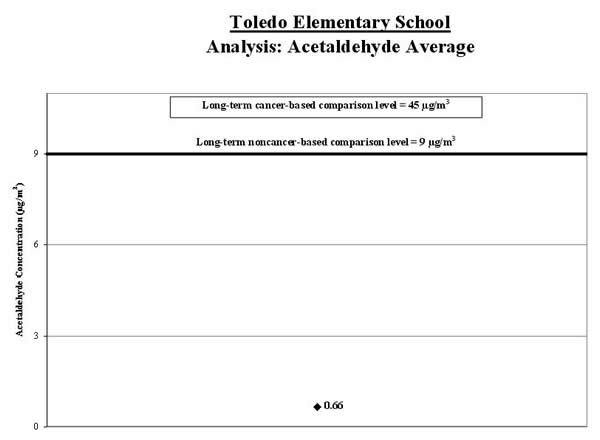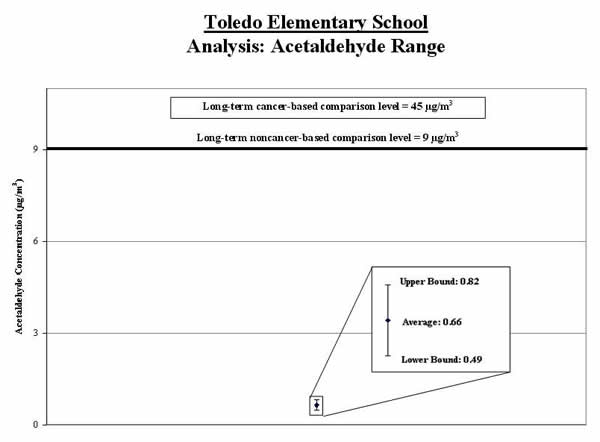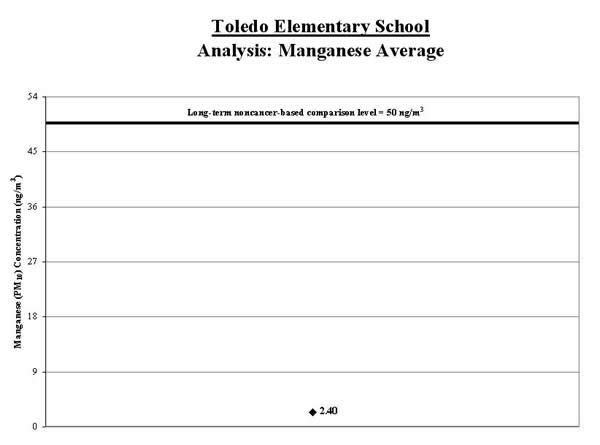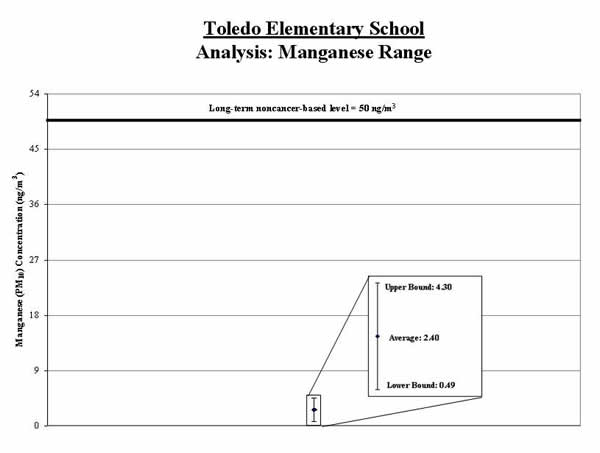Assessing Outdoor Air Near Schools
Toledo Elementary School - Toledo, OR
Results and Analysis of EPA’s monitoring
EPA selected this school for monitoring because it is located near a paper mill which is a source of air toxics emissions. Computer models were used to determine which air toxics may be present at elevated levels in the outdoor air near the school. These models showed that acetaldehyde, acrolein, and manganese could be present in the air around the school and prompted EPA to test to see if the levels present may be of concern.
| Primary Findings | Levels of acetaldehyde and manganese in the air at the school are below levels of concern for short-term and long-term exposure. Results of a recent short-term laboratory study have raised questions about the consistency and reliability of monitoring results of acrolein. As a result, EPA will not use these acrolein data in evaluating the potential for health concerns from exposure to air toxics in outdoor air as part of the School Air Toxics Monitoring project. |
| Key Pollutants Monitored | Acetaldehyde. Inhalation may affect the respiratory system if people are exposed to high levels. Manganese. Inhalation may affect the nervous system if people are exposed to high levels. Acrolein. Exposure to high levels can cause irritation of the eyes, nose, and throat. |
| Next Steps | Based on the analysis described here, EPA will not extend air toxics monitoring at this school.
EPA remains concerned about emissions from sources of air toxics and continues to work to reduce those emissions across the country, through national rules and by providing information and suggestions to assist with reductions in local areas. |
Summary of Study Approach and Findings
Approach:
- A monitor collected air samples from August 29, 2009 through December 3, 2009 at the Toledo Elementary School in Toledo, Oregon.
- We posted individual air sample results on this website throughout the monitoring period to keep your community informed during the monitoring period.
- During the monitoring period, we evaluated the monitored concentrations to see if there was a concern from short-term exposures (e.g., several weeks).
- When the monitoring was complete, we analyzed the results to see if there was a concern from long-term exposures (over a lifetime).
- Also, when the monitoring was complete, we evaluated all the air samples from the on-site monitor. We also evaluated information on wind speed and wind direction from a weather monitor at the school, along with historical weather information and information about nearby source(s) of acetaldehyde, acrolein, and manganese emissions.
Findings:
- Our analysis found that levels of acetaldehyde and manganese in the air at the school are below levels of concern for long-term exposure.
- Results of a recent short-term laboratory study have raised questions about the consistency and reliability of monitoring results of acrolein. As a result, EPA will not use these acrolein data in evaluating the potential for health concerns from exposure to air toxics in outdoor air as part of the School Air Toxics monitoring project.
- The concentrations of acetaldehyde and manganese measured at the school are lower than those suggested by the information that helped identify this school for monitoring.
- The process to identify schools for monitoring relied on emissions estimates and other information. Ambient air monitoring at the school allowed measurement of what was actually in the air.
- Information from the nearby source indicates that this facility was operating at full production during the sampling period.
- Because the analysis shows monitored concentrations of acetaldehyde and manganese levels to be below levels of concern, EPA will not extend air toxics monitoring at Toledo Elementary School.
- Click here for additional information
How We Analyzed the Information We Collected at this School
The analysis considered whether the information collected at the school might raise concerns for the health of children or adults at the school. We looked at the following types of information:
- Measured acetaldehyde and manganeseconcentrations and information on acetaldehyde and manganese
- Measured wind direction and wind speed at the school
- Information about nearby sources of acetaldehyde and manganeseemissions
Analysis of Measured Acetaldehyde Concentrations:
1. Calculate the average:We calculated the average of the acetaldehyde measurements (shown by the black diamond in the graph below). We compared this average to the long-term comparison levels (thick line on the graph below).
Result: The average acetaldehyde level for the samples collected was well below the long-term comparison levels.

2. Calculate a range: To account for varying air concentrations of acetaldehyde, we calculated a range around the average. We did this by estimating high and low values that the longer-term concentrations might reach using common statistical tools. We compared the highest point in the range (called the “upper bound”) to the long-term comparison levels.
Result: The high end of the range is lower than the comparison levels.

Analysis of Measured Manganese Concentrations:
1. Calculate the average:We calculated the average of the manganese measurements (shown by the black diamond in the graph below). We compared this average to the long-term comparison level (thick line on the graph below). The long-term comparison level represents the level of manganese in the air that is below levels associated with health concerns, even if someone breathed air containing manganese at that level all day, every day over their lifetime.
Result: The average manganese level for the samples collected was well below the long-term comparison level. The health concern is low.

2. Calculate a range: To account for varying air concentrations of manganese, we calculated a range around the average. We did this by estimating high and low values that the longer-term concentrations might reach using common statistical tools. We compared the highest point in the range (called the “upper bound”) to the long-term comparison level.
Result: The high end of the range is lower than the comparison level. The health concern is low.

Analysis of Measured Wind Direction and Wind Speed at the School
We took measurements of wind direction and speed every day during the sample period. We took special note of the wind speed and direction on the days we took measurements of acetaldehyde and manganese. Due to instrument error at Toledo Elementary School, all wind information was from the meteorological station at the Georgia-Pacific facility which lies approximately 0.66 miles southwest of the school.
| What we looked at | What we found |
| We looked at whether the wind data taken on the days we took measurements of acetaldehyde and manganese are similar or different from the wind patterns during the entire sampling period. | We found the wind patterns taken on the days we took measurements of acetaldehyde and manganese to be somewhat similar to those observed during the entire sampling period. |
| We looked at whether the wind pattern during the sampling period is reflective of regional wind pattern over the long term. | The wind patterns at the Georgia-Pacific meteorological site across sampling dates are somewhat similar to those observed over a two-year period of wind observations at the same location, suggesting that on a regional scale, the 3-month sampling period may be representative of year-round wind patterns. |
Analysis of Information on Nearby Source of Acetaldehyde and Manganese Emissions
| What we looked at | What we found |
| Whether we could determine if the sources were operating as usual during the sampling period | Information from the nearby source indicates that this facility was operating at full production during the sampling period. |
| The concentrations of acetaldehyde and manganese measured at the school are lower than those suggested by the information that helped identify this school for monitoring.
The nearby source of acetaldehyde and manganese has a Title V operating air permits issued by the State of Oregon that includes operating requirements. |
Additional Information
Technical Report for School: Assessing Outdoor Air Near Schools: Toledo Elementary School (Toledo, OR) (PDF) (32pp, 256k). The technical report is geared toward risk assessors, risk managers, and other regulatory agencies.
Background on School Monitoring Effort
General Questions and Answers for School Monitoring Effort
